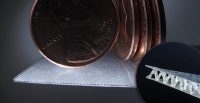Displaying news tagged: microlattice
New Pads Absorb Shock Better Than Foam With Air Flow and Easy Manufacture

HRL Laboratories has published test results showing shock-absorbing pads made from HRL’s microlattice material had up to 27% higher energy absorption efficiency than the current best-performing expanded polystyrene foam when sustaining a single impact and up to 35% higher energy absorption efficiency than state-of-the-art vinyl nitrile foam when impacted repeatedly. Microlattice could replace current foams in protective packaging, shock isolators for electronics, vehicle interiors, and helmet padding from football to bicycle helmets.
HRL Laboratories Achieves Guinness World Record for Lightest Metal

HRL researchers originally made headlines with a famous image of a metal microlattice structure resting atop an unaffected dandelion. Now the material has been vetted and confirmed by the Guinness book as having no peer among metals when it comes to weight.
Lightest. Metal. Ever.
Boeing features HRL Laboratories in this video about the Microlattice, the lightest metallic structure ever made. At 99.99% air, it’s light enough to balance on top of a dandelion, while its structure makes it strong. Strength and record breaking lightness make it a potential metal for future planes and vehicles.
Game Changing Space Travel: HRL is Developing Ultralight Materials for Future Aerospace Vehicles and Structures
HRL Laboratories, LLC announced today that it will develop new ultra-lightweight materials for future aerospace vehicles and structures under NASA’s Game Changing Development Program. These new materials can enable NASA to reduce the mass of spacecraft for deep space exploration by 40 percent and are necessary for the journey to Mars and beyond.
Lightweight Sandwich Structures Lay the Groundwork for Micro-Drones

According to Dr. Christopher Roper, HRL senior research staff engineer and co-author of “Enabling Ultra-Lightweight Structures: Microsandwich Structures with Microlattice Cores,” published in APL Materials, “Sandwich structures improve the performance of weight-sensitive vehicles like airplanes and helicopters because they’re lighter than solid materials.”
Popular Mechanics Recognizes HRL’s Breakthrough Development of Ultralight Microlattice Materials
Researchers from HRL Laboratories are among the honorees of Popular Mechanics’ 2012 Breakthrough Awards for their development of ultralight microlattice materials.
HRL Researchers Develop World’s Lightest Material
Researchers at HRL Laboratories, LLC, announced today they have developed the world’s lightest material with a density of 0.9 mg/cc, approximately one hundred times lighter than Styrofoam™.
HRL Announces Extraordinary New Lightweight Materials
Amazing new materials that could spawn an entire generation of lightweight technologies have been generated by HRL Laboratories, LLC in collaboration with the University of Southern California’s Composites Center.